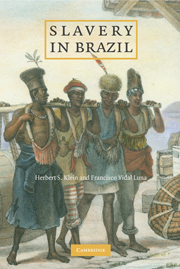Book contents
- Frontmatter
- Contents
- Preface
- I THE POLITICAL ECONOMY OF SLAVE LABOR
- 1 Origins of the African Slavery in Brazil
- 2 The Establishment of African Slavery in Brazil in the Sixteenth and Seventeenth Centuries
- 3 Slavery and the Economy in the Eighteenth Century
- 4 Slavery and the Economy in the Nineteenth Century
- 5 The Economics of Slavery
- II BRAZILIAN SLAVE SOCIETY
- III END OF SLAVERY
- Bibliography
- Index
2 - The Establishment of African Slavery in Brazil in the Sixteenth and Seventeenth Centuries
Published online by Cambridge University Press: 05 June 2012
- Frontmatter
- Contents
- Preface
- I THE POLITICAL ECONOMY OF SLAVE LABOR
- 1 Origins of the African Slavery in Brazil
- 2 The Establishment of African Slavery in Brazil in the Sixteenth and Seventeenth Centuries
- 3 Slavery and the Economy in the Eighteenth Century
- 4 Slavery and the Economy in the Nineteenth Century
- 5 The Economics of Slavery
- II BRAZILIAN SLAVE SOCIETY
- III END OF SLAVERY
- Bibliography
- Index
Summary
Why did the Portuguese decide massively to import Africans into Brazil, when this was a minor part of their world empire and when the dominant overseas institutions it developed were trading factories and not colonies? In fact, the first thirty years of colonial contact in Brazil fit the African and Asian patterns more than the colonization of Madeira and the Azores.
The initial conquest and contact with Brazil was marginal to the great Portuguese international imperial expansion of the fifteenth and sixteenth centuries. Claiming the region through expeditions that found Brazil on the road to the East Indies, the Portuguese were little interested in its immediate development. With the riches of Asia available to them as the Portuguese opened up a water route to the islands of Indonesia and then to India, Japan, and China, there was little demand for the development of Brazil beyond an emporium for tropical products unavailable in Europe. The first commercial exports in fact were woods, from which were extracted dyes. These so-called Brazil wood trees were usually cut by local Indian groups and then shipped by the Portuguese to Europe on a seasonal basis, with no permanent Portuguese settlers residing in America. Castaways and other marginal Portuguese began living with local Tupi–Guarani-speaking Indian communities along the coast and became the crucial cultural brokers who kept the contact with the mother country alive.
- Type
- Chapter
- Information
- Slavery in Brazil , pp. 19 - 34Publisher: Cambridge University PressPrint publication year: 2009



